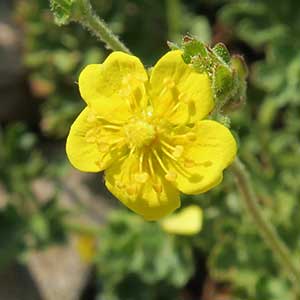Potentilla brevifolia
Potentilla gracilis
short-leaf cinquefoil, sparse-leaf cinquefoil
graceful cinquefoil, northwest cinquefoil, potentille grêle, slender cinquefoil
usually absent or inconspicuous, uncolored.
ascending to erect, (0.5–)2–7(–12) dm.
petiole 1–4 cm, eglandular hairs absent or sparse, spreading, less than 1 mm, weak, glands abundant.
usually not in ranks, palmate, rarely subpalmate, 4–40(–55) cm;
petiole (2–)3–25(–45) cm, long hairs sparse to dense, appressed to spreading, 0.5–2(–3) mm, weak to stiff, short hairs absent, crisped hairs usually absent, cottony hairs absent or sparse to abundant (var. owyheensis), glands absent or sparse;
leaflets 5–9, on tip, rarely less than distal 1/10, of leaf axis, separate to overlapping, largest ones oblanceolate to elliptic or obovate, (1.5–)2–9(–11) × (0.7–)1.5–4 cm, margins flat to revolute, distal (2/3–)3/4 to nearly whole length evenly to unevenly incised 1/4–3/4+ to midvein, undivided medial blade 2–20 mm wide, teeth (4–)6–10(–11) per side (sometimes secondarily toothed), linear to broadly lanceolate, 2–20(–35) mm, surfaces ± similar to strongly dissimilar, abaxial green or pale green to white, usually not glaucous, long hairs sparse to abundant (sometimes mostly on veins), short-crisped hairs absent or sparse to abundant, cottony hairs absent or sparse to dense, glands usually absent or obscured to sparse, sometimes common, adaxial dark green to grayish, long hairs sparse to ± abundant, rarely absent or dense, short-crisped hairs absent or sparse, cottony hairs absent or sparse to abundant (var. owyheensis), glands usually absent or sparse to sometimes common.
1–4(–5).
(4–)10–50(–60)-flowered.
0.3–3 cm.
epicalyx bractlets lanceolate-elliptic to ovate, 2–4 × 0.8–2 mm;
sepals 3–5(–7) mm, apex broadly acute to obtuse;
petals 3.5–6.5 × 3–5 mm;
filaments 1–2.5 mm, anthers 0.5–0.6 mm;
carpels 10–15.
epicalyx bractlets linear to narrowly lanceolate or elliptic, 2–6(–8) × 0.5–1.5(–2.5) mm, hairs sparse to abundant, rarely dense, ± appressed to ascending, rarely spreading, glands usually absent or inconspicuous;
hypanthium 3.5–6 mm diam.;
sepals 4–8(–10) mm, apex acute to long acuminate;
petals (3–)4–10(–11) × (3–)4–10(–12) mm;
filaments (1–)1.5–2.5(–3.5) mm, anthers 0.6–1.2(–1.6) mm;
carpels (15–)20–50, styles ± tapered, papillate-swollen proximally, (1–)1.5–2.5(–3) mm.
1–1.5 mm.
1–1.8 mm.
Potentilla brevifolia
Potentilla gracilis
Potentilla brevifolia is found mainly in alpine situations in the Pioneer, Sawtooth, Smoky, and White Cloud mountains of central Idaho; the Madison Range of western Montana; the Jarbidge Range of northeastern Nevada; the Blue, Steens, and Wallowa mountains of eastern Oregon; and the Teton Range of northwestern Wyoming. The elongate caudices are easily covered by moving soil and talus.
(Discussion copyrighted by Flora of North America; reprinted with permission.)
Varieties 5 (5 in the flora).
Because variation within Potentilla gracilis and other members of sect. Graciles is still far from resolved, taxonomic recognition is given to only the most distinctive extremes and that mostly at the varietal level. The goal is to call attention to areas that need study rather than to provide a full resolution, and even this leaves out some large, widespread populations in both keys and descriptions. The taxonomic placement of some available names, such as P. glomerata A. Nelson, P. longipedunculata Rydberg, and P. macropetala Rydberg, likewise remains unresolved.
The vouchers for the report by M. L. Fernald (1950) of Potentilla gracilis and P. pulcherrima from New Hampshire are presumably specimens collected in Coos County by A. S. Pease (NEBC). The three collections differ from one another, corresponding most closely to var. fastigiata, var. flabelliformis, and P. pulcherrima. The presence of such diversity in the same meadow, all as disjunct occurrences, suggests an artificial, non-persisting introduction.
(Discussion copyrighted by Flora of North America; reprinted with permission.)
1. Petioles: cottony hairs usually abundant, rarely sparse. | var. owyheensis |
1. Petioles: cottony hairs usually absent | → 2 |
2. Leaflets incised 1/4–1/2 to midvein, undivided medial blade 5–20 mm wide, teeth narrowly lanceolate to ovate | → 3 |
2. Leaflets incised 3/4+ to midvein, undivided medial blade 2–6 mm wide, teeth linear | → 4 |
3. Leaflet surfaces usually strongly dissimilar, abaxial white, sometimes grayish, crisped-cottony hairs abundant to dense, rarely sparse, adaxial green; near coastal n California to Alaska. | var. gracilis |
3. Leaflet surfaces ± similar to ± dissimilar, abaxial pale green to greenish gray, crisped hairs absent or sparse to abundant, cottony hairs usually absent, adaxial green to grayish green; widespread. | var. fastigiata |
4. Leaflet surfaces usually ± dissimilar, abaxial grayish to whitish, long hairs abundant to dense, crisped hairs sparse to abundant, cottony hairs usually absent, adaxial green to grayish green, teeth 3–13(–20) mm, not secondarily toothed; petioles 2–15(–25) cm. | var. elmeri |
4. Leaflet surfaces strongly dissimilar, abaxial white, long hairs sparse to common (mostly on veins), cottony or crisped-cottony hairs dense, straight hairs dense, mostly on veins, adaxial usually dark green, sometimes grayish green, teeth (8–)10–20(–35) mm, often secondarily toothed; petioles (7–)10–25(–30) cm. | var. flabelliformis |
- Local floras:
BC,
CA,
OR,
WA
- Local Web sites:
CalFlora,
CalPhotos,
Flora NW,
MI Flora,
MN Wildflowers,
PNW Herbaria,
SW CO Wildflowers,
Turner Photog.
WildflowerSearch
iNaturalist (observations)
USDA Plants Database
- LBJ Wildflower Center
- SEINet
- Plants of the World Online
- Encyclopedia of Life
- Wikipedia
- Google Image Search


